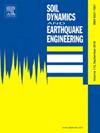用粒子群优化方法模拟单向和双向频谱兼容的地面运动
IF 4.2
2区 工程技术
Q1 ENGINEERING, GEOLOGICAL
引用次数: 0
摘要
在现代抗震规范中,频谱兼容地震记录被广泛推荐用于评估新建筑和既有建筑的抗震性能。本文提出了一种利用粒子群优化算法(PSO)生成单向和双向频谱兼容地震动的新方法。首先对种子记录进行连续小波变换(CWT)提取小波系数;然后,通过粒子群算法获得生产频谱兼容分量的最佳小波系数,根据每次地震动时频特性与响应谱之间的物理关系确定动态解空间。此外,归一化径向谱加速模式(RadSAP)有效地捕捉了双向记录的方向变化特征。在产生频谱兼容的地面运动的同时维护radsap的挑战增加了这项研究的复杂性。因此,本文还详细介绍了在保持radsap的同时产生双向频谱兼容的地面运动的方法。通过设计的频谱、特定地点的目标频谱和其他指标(例如强度、频率和持续时间)来证明建议方法的有效性。本文章由计算机程序翻译,如有差异,请以英文原文为准。
An efficient method for simulating uni- and bi- directional spectrum-compatible ground motions using particle swarm optimization
Spectrum-compatible seismic records are widely recommended in modern seismic codes for assessing the seismic performance of both new constructions and pre-existing buildings. This study introduces a novel method to generate uni- and bi- directional spectrum-compatible ground motions utilizing particle swarm optimization (PSO). Initially, seed records are transformed via continuous wavelet transform (CWT) to extract wavelet coefficients. Subsequently, the optimal wavelet coefficients for producing spectrum-compatible components will be obtained through PSO with a dynamic solution space determined according to the physical relationship between the time-frequency characteristics of each ground motion and the response spectrum. Moreover, the normalized radial spectral acceleration pattern (RadSAP) effectively captures the orientation variation characteristics of bidirectional records. The challenge of maintaining RadSAPs while generating spectrum-compatible ground motions adds complexity to this research. Consequently, this paper also details the methodology for generating bidirectional spectrum-compatible ground motions while preserving the RadSAPs. The effectiveness of the proposed approach is demonstrated through the designed spectrum, site-specific target spectrum and additional metrics (e.g. intensity, frequency and duration).
求助全文
通过发布文献求助,成功后即可免费获取论文全文。
去求助
来源期刊

Soil Dynamics and Earthquake Engineering
工程技术-地球科学综合
CiteScore
7.50
自引率
15.00%
发文量
446
审稿时长
8 months
期刊介绍:
The journal aims to encourage and enhance the role of mechanics and other disciplines as they relate to earthquake engineering by providing opportunities for the publication of the work of applied mathematicians, engineers and other applied scientists involved in solving problems closely related to the field of earthquake engineering and geotechnical earthquake engineering.
Emphasis is placed on new concepts and techniques, but case histories will also be published if they enhance the presentation and understanding of new technical concepts.
 求助内容:
求助内容: 应助结果提醒方式:
应助结果提醒方式:


